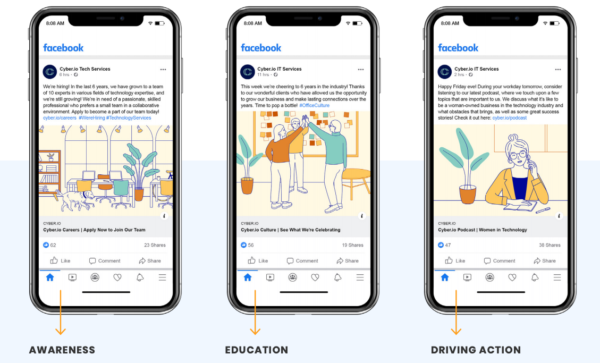
Social media is by far one of the most effective marketing techniques available to technology companies trying to generate leads and win new business — but it’s also one of the least understood and therefore underleveraged. Why is this?
In part, the frequent changes in rules of engagement leave business owners frustrated. It’s also sometimes difficult to tie social media marketing directly to new business because it’s often part of the journey, not the endpoint.
However, social media marketing for technology services companies need not carry the shroud of mystery that it often does. Peeling away at the layers reveals a less overwhelming, more impactful process that can deliver some tangible returns.
Tools and advice to help you find clients for your web development, IT, or computer systems design business.
The starting point: social media strategy for technology services
Where to begin? First, you’ll need to nail down your strategy, meaning setting some expectations around how you’ll use social media to build visibility for your company’s brand, how you’ll use it to generate leads, or even how you might use it to attract talent.
A social media strategy typically addresses the following items:
- Business purpose: are you aiming for overall brand awareness, lead generation, talent acquisition, or all of the above? Defining your business will help you prioritize which social media platforms you’ll leverage and what type of content you’ll post.
- Social media platform(s): which social media platforms do your customers use?
- Rhythm and cadence: depend on your goals and platforms, how frequent will your activity need to be?
- Specific goals to track and measure: what outcomes do you expect to achieve? Ensure your strategy outlines how to measure, track, and report on those outcomes so you know if your strategy is working.
Defining purpose and priorities for your technology services social media strategy
Social media marketing for technology services companies can play an important role in your company’s overall marketing strategy in five distinct ways:
1. Networking
Social media’s original intended role as the digital counterpart to the tradition of face-to-face networking is still alive and well. Treat Twitter, LinkedIn, and Facebook as an opportunity to meet new people and develop important business and client relationships — in a digital setting.
And, like an in-person event, you’ll need to “work the room.” Post content that offers useful information and helps educate people, not content that’s self-promotional.
Finally, people expect that you’ll reply to their tweets, comments, and questions, as well as share other people’s content — not just your own.
2. Content promotion
And speaking of content, social media is one of the easiest and cheapest ways to promote your company’s content. Social media marketing helps technology services companies promote their content via multiple channels, which in turn helps build both reputation and visibility — i.e., your brand.
A word of warning on content promotion, though — it’s important not to overdo self-promotion. Social media is reciprocal, and you need to balance self-promotion with sharing important content created by other industry thought leaders. While there seems to be no widely accepted standard for how much of others’ content to share, there is a bias toward education. Leave your marketing collateral on your website and focus oneducating when posting content on your social networks. In other words, don’t go for the hard sell on social media.
Now, of course, this doesn’t mean you completely avoid promotional posts, including job openings, company milestones (new hires, new locations, new products) and the like. However, focusing the majority of your posts on informative, valuable, and differentiated thought leadership makes your audiences all the more receptive to the promotional content you’ll post on occasion.
3. Visibility through SEO (search engine optimization)
The act of posting valuable content on your social networks alone can drive visibility for your company, but there is another way that social media can boost your visibility, and that is through incorporating keywords into your content as an SEO strategy.
By sharing content widely, you attract “natural” links, which have a very clear impact on the page authority of your technology services website. How does this happen? People who find your content to be valuable become your advocates by sharing your content with their own networks. Their connections do the same, and the circle continues. These are social signals that notify Google that your site content is valuable — and those signals could indirectly improve your search rankings.
Another hidden benefit of social media is that its content is searchable — at least for Twitter and LinkedIn. That means that your tweet, which links back to your website’s blog, may be found by someone doing a simple Google search — another opportunity to gain website traffic.
4. Finding and understanding your audience
Social media is an excellent way to gather useful intel and information on your target audience, whether a prospective customer, prospective recruit, or any other type of user.
Before you meet with a new customer, interview a past customer for a case study, or hire a new employee, you should check out their social media streams. You will learn a lot about their personality, authority, reputation, and visibility. Social media is also an easy way to research marketplace trends and engage with the competition, helping you stay on top of their initiatives and, perhaps, allowing for advantageous collaboration. This type of intelligence gathering is sometimes referred to as “social listening.”
5. Recruiting
Social media is a natural recruitment tool, whether it be for finding new employees or seeking out business partners.
LinkedIn and Facebook let you post highly targeted jobs focusing on users with certain résumé attributes, and provides real-time analytics showing, among other things, who has viewed the post. And of course, LinkedIn is well known as a good place to search for a new position or to find the right talent.
Choosing a platform of focus for your technology services social media marketing
In order to realize the most return on social media marketing for technology, you must be on the right platform.
Should you prioritize Facebook or Instagram? What about YouTube? And everyone’s been talking about LinkedIn. Many folks make the mistake of selecting the channel before they figure out what their goal should be. That’s backwards and will have you wasting both time and money in no time.
Each social media platform has a slightly different personality and can help you map out where you’ll invest your energies. Here is a great article that offers detailed profiles of each platform, but we’ll summarize below for reference:
With nearly 700 million active users, LinkedIn is considered a top channel for B2B marketing. This is a place of solid dialogue. Post your best articles, blogs, and network like a true professional. Practice good social citizenship by commenting on posts when you find them valuable, and always respond to others if they’ve commented on yours! If you have time for one channel and one channel only, LinkedIn is the place to be as a technology services provider.

Twitter has a healthy following of users too, but the interaction is less about generating leads and starting in-depth dialogues than it is about a quick scan or read of topical content. Whereas you would post an entire article on LinkedIn, an associated tweet might be a short quip about the content with a link to the source material.
If LinkedIn is all about your expertise, Facebook is an excellent place to showcase your employer brand. Of course, you can post your blogs and thought leadership content as well, but Facebook is the most appropriate channel for posting about company outings, happenings in the office, or — these days — digital meeting or work from home antics.
Active Facebook accounts can be great recruiting tools since future employees give as much weight to workplace environment and culture as they do to the compensation package.

YouTube
If you have a good arsenal of video content, YouTube can be an effective channel for bringing that video content to life. Of the 2 billion per month YouTube users, 90% say they discover new companies or new products through this channel.
Sometimes it will make sense to be on multiple social media platforms. Each channel is unique and requires a different strategy, so you should consider the characteristics of the different platforms as part of your decision process. If you are in doubt, start small with one platform and build from there.
The bottom line
Social media helps companies build awareness, educate their audiences, and drive action. It’s important to remember though that social media is but part of the overall marketing equation.
Sometimes social media the first place where people find and engage with your company, and other times it’s somewhere in the middle. As its role in a comprehensive technology services marketing strategy continues to grow, social media marketing for technology is becoming a “must have” tool.
Increasing numbers of companies are jumping into social media with both feet, realizing that its reach is great while its cost is low.
Looking for a better idea of how social media marketing fits into your marketing strategy? Check out The Download: Making Sense of Online Marketing for Technology Services. It’s a free, comprehensive guide to all the digital marketing must-haves that help you find new clients and grow your business online.




